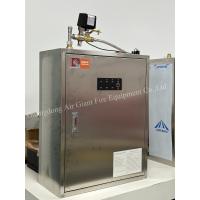Electromagnetic Kitchen Fire Extinguishing System (For Grease
Ducts)
Description of Kitchen Fire Suprresion System
Activation Method Description:
1. Automatic Activation Method:
Thermal Detection: When a fire occurs in the kitchen oil pot, the
heat generated by the flames will cause the temperature inside the
hood to rise. When the temperature reaches the preset thermal
threshold of the fire suppression system (usually 183°C to 185°C),
the thermal detector will automatically disconnect, triggering the
fire suppression system to activate automatically.
Release of Fire Extinguishing Agent: Once the fire suppression
system is activated, it will release fire extinguishing agents
(such as dry powder, water-based agents, etc.) through atomizing
nozzles, spraying them onto the oil pot and inside the hood. These
agents will either chemically react with the burning oil or
physically isolate it, forming a covering layer to cut off the air
supply and extinguish the flames.
Cooling Down: After the fire suppression system sprays the
extinguishing agent, it typically activates a water flow valve
automatically, spraying water onto the oil pot and exhaust hood to
cool them down and prevent re-ignition. The cooling water is
sprayed for about two minutes before the system automatically shuts
off the water.
2. Manual Activation Method
Fire Detection: In the early stages of a fire or if the automatic
activation system fails, on-site personnel can manually activate
the fire suppression system.
Operating the Manual Activation Device: Follow the instructions on
the device to remove the safety pin, pull out the ring, or press
the button, causing the drive valve to activate and release the
fire extinguishing agent from the high-pressure cylinder.
Observing the Extinguishing Effect: After manually activating the
fire suppression system, observe whether the fire source is
completely extinguished and take necessary follow-up measures.
3. Mechanical Emergency Activation Method
Confirming Automatic and Manual Activation Failure: When both
automatic and manual activation methods fail to start the device
normally, the mechanical emergency activation method can be used.
Operating the Mechanical Drive Valve: Manually operate the drive
valve handle to open the mechanical drive valve, releasing the fire
extinguishing agent to extinguish the fire.
Components of Kitchen Fire Suprresion System
-- Temperature Detector (Thermal Element):Typically uses fusible alloy or glass bulb thermal sensors. When
the temperature reaches the set value (usually 160°C–260°C), it
automatically melts or breaks, triggering the fire suppression
system.
-- Fire Suppressant Storage Cylinder: Stores specialized fire extinguishing agents (e.g., wet chemical
fire suppressant).
-- Release Valve: Automatically opens when activated by the detection system,
discharging the fire suppressant through the piping.
-- Manual Activation Device (Emergency Button): Installed in a visible location for manual fire suppression
activation by personnel.
-- Nozzle/Spray Pipe: Positioned over high-risk fire areas such as stove tops and range
hoods to ensure even distribution of the suppressant over the fire
source.
-- Mechanical/Electric Control Unit: Receives signals from detectors, automatically shuts off gas/power
(via a linked valve), and activates the suppressant release.

Working principle of kitchen Fire Suprresion System
** Flame Detection and Activation
Thermal Fusible Metal Cable Release Device: When the oil pot on the
kitchen stove catches fire, the intense heat from the flames will
cause the thermal fusible metal cable release device to heat up and
detach.
Thermal Detection System: Simultaneously, the thermal detection
system will detect the flames or high temperature, triggering the
release mechanism of the kitchen fire suppression system. During
this step, the system pressurizes the fire extinguishing agent
storage container and activates all auxiliary electric shut-off
devices (such as gas shut-off valves) and alarm linkage devices.
** Fire Extinguishing Agent Release
Fire Extinguishing Agent Spray: Once the release mechanism is
activated, liquid fire extinguishing agents (such as foam, dry
powder, or other specialized agents) are sprayed through nozzles
onto the surfaces of kitchen stove equipment, as well as inside the
exhaust hood, grease filter, and exhaust ducts. These specialized
agents can quickly extinguish flames in the oil pot and form a
covering layer to suppress the combustion of oil vapors, thereby
preventing re-ignition.
Type of Fire Extinguishing Agent: Some kitchen fire suppression
systems use high-pressure gas to propel the fire extinguishing
agent. In this case, a mechanical actuator pierces the
high-pressure gas cylinder, releasing high-pressure gas into a
pressure-reducing valve. The gas then enters the top of the fire
extinguishing agent cylinder, pushing the agent through delivery
pipes to the nozzles for spraying.
** Cooling and Flushing
Water Spray Valve Activation: After the system's extinguishing
agent is sprayed, the water spray valve on the system will
automatically open after approximately 3 to 8 seconds.
Water Flow Flushing: Water flows through the fire extinguishing
agent pipes and nozzles, rapidly cooling and flushing the oil and
stove equipment surfaces, ensuring the fire source is completely
extinguished and preventing re-ignition.
** System Reset and Inspection
Manual Reset: Some kitchen fire suppression systems require manual
reset after extinguishing a fire, such as manually resetting the
gas emergency shut-off valve to reopen.
System Inspection: After each use or periodically, conduct system
inspections to ensure the device is in good working condition, the
fire extinguishing agent is sufficient, and all components are
tightly connected without leaks.

Advantage of Kitchen Fire Suprresion System
**Preventing Re-ignition
**Environmentally Friendly and Safe
**Strong Applicability
**High-Efficiency Fire Suppression
Application of Kitchen Fire Suprresion System
Kitchen Fire Suppression Device is mainly used at the following
site: hotel, restaurant kitchen, the catering center of the
stadium, large/medium/small restaurant, fast food restaurant, the
catering center of the airport, the kitchen of the office and
hospital, large office building restaurant, the kitchen of
industrial and mining enterprises, college canteen and so on.

Packages of Kitchen Fire Suprresion System
We pack products with first polyfoam and then the wooden cases.
Once products are too big or customers require a pallet for
products, we will make products a pallet. The following pictures
are the common packing of products:












